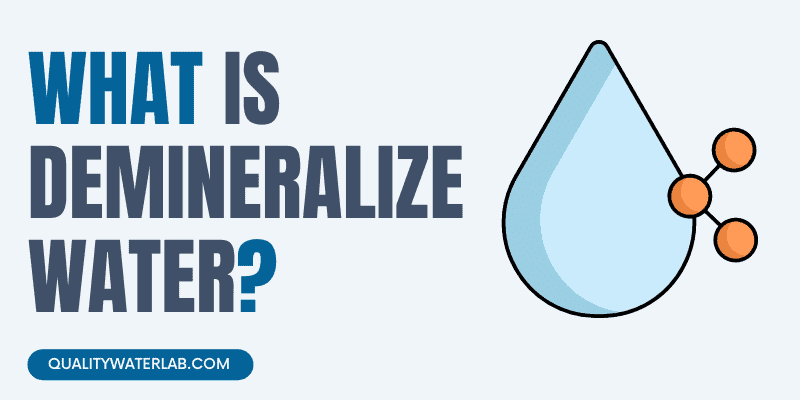
Ava, the founder and chief editor of QWL is a water filtration expert and a proud member of the Water Quality Association (WQA) and a supporter of CharityWater.org that helps bring fresh clean water to those in need.
December 11, 2022
by Ava
Ava, the founder and chief editor of QWL is a water filtration expert and a proud member of the Water Quality Association (WQA) and a supporter of CharityWater.org that helps bring fresh clean water to those in need.
Last Updated on December 11, 2022 by Ava
We think of water as pure, but it can contain hundreds of substances. Most, like minerals, are dissolved, so you can’t see them, but you can taste and feel their effects.
Calcium, for example, occurs naturally in water, and it’s not hazardous to drink. But there are home, industrial and laboratory applications that require high purity water with the minerals removed. Let’s take a closer look at the types of demineralized water, how they’re made and why you may need them around the house.
Key Takeaways:
Demineralized water is a generic term for water with no minerals. There are several kinds of water with low mineral content. These are three types that you may be familiar with.
Softened water is partially demineralized. It contains salt ions, so it doesn’t meet the strictest definition of demineralized water for most purposes. But it has very low levels of calcium and magnesium, the most common mineral ions in water.
Deionized water has been treated to remove electrically charged mineral and salt ions, but it may have other impurities. The deionization process doesn’t remove uncharged molecules, so it’s of lower purity than distilled water.
Distilled water is the purest form of demineralized water. It’s free of dissolved minerals and salts, bacteria, heavy metals and other organic contaminants you might find in softened or deionized water.
Demineralized water is used for industrial and scientific purposes in which the physical, electrical or chemical composition of mineral ions is problematic.
Minerals have an electrical charge, wreaking havoc on sensitive manufacturing equipment. Demineralized water has low conductivity, making it ideal for automotive and computer chip manufacture.
Chemically, minerals can affect laboratory applications and the performance of medicines, so mineral-free water is a must for hospitals and pharmaceutical manufacturing.
Minerals can also leave behind a chalky residue called limescale that builds up in equipment used in electronics manufacture. Mineral-rich water also affects the taste of products it’s made with, so it’s popular among food producers.
Around the house, demineralized water is used for:
Demineralized water is used in aquariums to lower the pH levels in fish tanks, but use only deionized or distilled water. Softened water contains too much sodium.
Tap water with mineral salts can shorten the life of lead-acid batteries. Deionized or distilled water is a better choice.
Softened, deionized and distilled water are popular among home brewers because the pH is higher, mirroring the water quality in the world’s best beer-producing regions.
Mineral buildup can clog the pins in single-serve coffee makers and the holes in steam irons.
Demineralized water is recommended for humidifiers and CPAP machines. Distilled water is the best choice for its low mineral content and purity.
Cooking water with high concentrations of dissolved solids can affect the taste of food and beverages. Committed coffee drinkers, for example, swear that purified water makes the best brew.
Most health experts recommend against drinking demineralized water exclusively. While the scientific consensus is that we get enough essential minerals from our food, water is still a valuable source of calcium and magnesium.
There are also potential health effects to consuming only mineral-free water, including dehydration and the erosion of tooth enamel. Still, it’s safer than drinking water contaminated with lead, arsenic or chemicals.
Demineralized drinking water has fans, but some people think it tastes flat. Tap water gets its characteristic flavor from minerals, so purified water may not be as refreshing. High mineral content, however, can give drinking water a bitter or metallic taste. So ultimately, it’s a matter of preference.
Removing minerals and salts from water is a relatively simple process with the right equipment. You can do it at home.
The different methods of producing demineralized water include:
Distillation is the world’s oldest and most common method of water purification. Unlike deionization, the distillation process kills pathogens, eliminates heavy metals and removes most common chemicals except for a few volatile organic compounds.
Distilled water is produced by condensing steam. Pure water is collected in a separate container while contaminants with boiling points lower than water are eliminated.
Ion exchange is a very effective method for demineralizing water. It’s the same process water softeners use to remove minerals but with specially manufactured resins.
Water softeners replace positive ions with negative ions using salt. But this ion exchange process adds sodium ions to water, so the end product has a higher mineral content than distilled or deionized water.
But the ion exchange resins used to deionize water eliminate both positive and mineral ions using hydrogen and hydroxide ions. The resulting water is nearly mineral-free and consists mostly of hydrogen ions. These unique ion exchange resins are found only in demineralizing filters.
Oxidation filters use air or chemicals to oxide dissolved minerals, transforming them into a solid form that can be filtered out by special media as water flows over it — typically Greensand, Birm or another granular substance that can remove fine particles.
Reverse osmosis relies on membrane filtration to remove contaminants from drinking water. More effective than other methods for removing some water impurities, it’s among the same advanced technologies public water systems use to eliminate mineral ions and more.
There’s no right way to make demineralized water, but if you’re not making it for industrial purposes, some methods are more cost-effective than others. Each has its pros and cons depending on your lifestyle and the contaminants in your water supply.
Commercial distillers used for industrial and scientific purposes are as large as rooms, but home distillers fit on the countertop and produce demineralized water without a big upfront investment. If you’re on a budget, you can buy one for less than $100.
But the distillation process is slow, so the production capacity is limited to 4-6 gallons per day. And it uses electricity, so the per-gallon price is lower than store-bought but higher than other demineralization methods.
If you need a large amount of demineralized water, distillation is impractical. But to produce water for steam irons or CPAP humidifiers, it’s ideal.
Ion exchange units are whole-house filtration systems. Plumbed into your main water line, they’re more expensive to purchase upfront than other filters, but their benefits are home-wide.
By controlling limescale, they eliminate hard water issues from fixture staining and high utility bills to plumbing problems and costly appliance repairs. But they require a drain, and they waste water during backwashing. Still, they produce large volumes of mineral-free water for pennies per gallon.
Oxidation removes minerals other filters can’t, including iron, offering whole-home protection against the effects of high mineral concentrations. If you’re wary of chemicals, consider an air oxidation filter.
A reverse osmosis system not only eliminates 99-percent of minerals, but it also removes sediment, chemicals, toxic heavy metals and more. If you need demineralized water, why not opt for the purest form possible? RO water is comparable to distilled.
Installed under the kitchen sink, reverse osmosis systems treat less water than whole-house filters but more than distillation. Starting at around $200, an RO system provides clean, mineral-free water for drinking and cooking.
The reverse osmosis process, however, is not without drawbacks. It’s inefficient, wasting two gallons of water for every gallon of pure water it produces. Still, it’s an affordable way to improve water quality for many families.
The minerals in your water aren’t the first thing you think about when you reach for a drink, but they can have a far-reaching impact on your health, home and business. The more you know about your water, the better decisions you can make about using it.

114 people found this helpful. Was this guide helpful to you?
Yes  No
No 
Ava here, I'm the owner and lead editor of QualityWaterLab.com. I've poured over a decade into researching and testing water filtration systems, creating a shortlist of the very best.
Having collaborated with elite brands and being proud members of the Water Quality Association (WQA), we're all about excellence. Dive into our resources, and together, let's find your perfect water solution.
QWL proudly supports charitywater.org, a nonprofit committed to providing clean and safe water, worldwide. Every drop matters. Join us in making a difference.